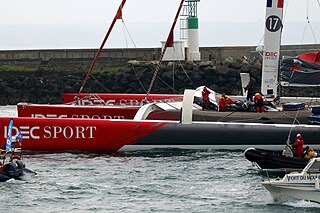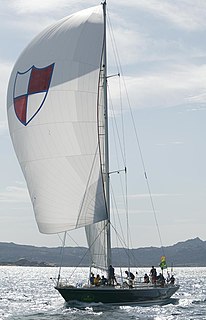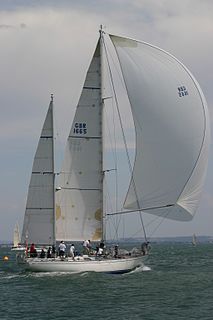 Race participants in Baltimore Inner Harbor, 2006 | |
| Formerly | Whitbread Round the World Race (1973-2001), Volvo Ocean Race (2001-2019) |
|---|---|
| Sponsor | Volvo |
| Partner | Inmarsat |
| First held | 1973 |
| Yachts used | Volvo Ocean 65 IMOCA Open 60 (Since 2021) |
| Start | Alicante, Spain (2017) |
| Finish | The Hague, Netherlands (2018) |
| Competitors | 7 |
| Legs | 10 |
| Champion | |
| Website | www |
The Ocean Race is a yacht race around the world, held every four years. [1] Originally named after its initiating sponsor, British Whitbread brewing company, it carried the name of its former owner, Swedish automobile manufacturer Volvo Cars and Swedish multinational manufacturing company, the Volvo Group from 2001. It has now, in 2019, been renamed The Ocean Race following four months of being known under a working title of "Fully-Crewed Around the World Race (FCAWR)" and is owned by Atlant Sports Group.

A yacht is a watercraft used for pleasure or sports. The term originates from the Dutch word jacht, and was originally referencing light fast sailing vessels that the Dutch Republic navy used to pursue pirates and other transgressors around and into the shallow waters of the Low Countries. The yacht was popularized by Charles II of England as a pleasure or recreation vessel following his restoration in 1660.
Whitbread plc is a British multinational hotel and restaurant company headquartered in Houghton Regis, Bedfordshire, United Kingdom. The company has its origins in brewing.

Volvo Cars, stylized as VOLVO, is a Swedish luxury vehicles company. It is headquartered on Torslanda in Gothenburg, and is a subsidiary of the Chinese automotive company Geely. The company manufactures and markets sport utility vehicles (SUVs), station wagons, sedans and compact executive sedans. The Volvo Group was founded in 1927 as a subsidiary of the ball bearing manufacturer SKF. When AB Volvo was introduced on the Stockholm stock exchange in 1935, SKF sold most of its shares in the company. Its cars are marketed as being safe, solidly built, and reliable.
Contents
Presently, the Netherlands holds the record of three wins, with Dutchman Conny van Rietschoten the only skipper to win the race twice.

The Kingdom of the Netherlands, commonly known as the Netherlands, is a sovereign state and constitutional monarchy with the large majority of its territory in Western Europe and with several small island territories in the Caribbean Sea, in the West Indies islands.

Cornelis "Conny" van Rietschoten was a Dutch yacht skipper who was the only skipper to win the Whitbread Round the World Race twice.
Though the route changes to accommodate various ports of call, the race typically departs Europe in October, and in recent editions has had either 9 or 10 legs, with in-port races at many of the stopover cities. The 2008–09 race started in Alicante, Spain, on October 11, 2008. [1] The route for the 2008–2009 race was altered from previous years to include stopovers in India and Asia for the first time. [2] The 2008–09 route covered nearly 39,000 nmi (72,000 km), took over nine months to complete, and reached a cumulative TV audience of 2 billion people worldwide. [3]

Alicante, or Alacant, both the Spanish and Valencian being official names, is a city and port in Spain on the Costa Blanca, the capital of the province of Alicante and of the comarca of Alacantí, in the south of the Valencian Community. It is also a historic Mediterranean port. The population of the city of Alicante proper was 330,525, estimated as of 2016, ranking as the second-largest Valencian city. Including nearby municipalities, the Alicante conurbation had 452,462 residents. The population of the metropolitan area was 757,085 as of 2014 estimates, ranking as the eighth-largest metropolitan area of Spain.
During the nine months of the 2011–12 Volvo Ocean Race, which started in Alicante, Spain in October 2011 and concluded in Galway, Ireland, in July 2012, the teams were scheduled to sail over 39,000 nmi (72,000 km) of the world’s most treacherous seas via Cape Town, Abu Dhabi, Sanya, Auckland, around Cape Horn to Itajaí, Miami, Lisbon, and Lorient.

Galway is a city in the West of Ireland, in the province of Connacht.

Ireland, also known as the Republic of Ireland, is a country in north-western Europe occupying 26 of 32 counties of the island of Ireland. The capital and largest city is Dublin, which is located on the eastern part of the island, and whose metropolitan area is home to around a third of the country's over 4.8 million inhabitants. The sovereign state shares its only land border with Northern Ireland, a part of the United Kingdom. It is otherwise surrounded by the Atlantic Ocean, with the Celtic Sea to the south, St George's Channel to the south-east, and the Irish Sea to the east. It is a unitary, parliamentary republic. The legislature, the Oireachtas, consists of a lower house, Dáil Éireann, an upper house, Seanad Éireann, and an elected President who serves as the largely ceremonial head of state, but with some important powers and duties. The head of government is the Taoiseach, who is elected by the Dáil and appointed by the President; the Taoiseach in turn appoints other government ministers.

Cape Town is the oldest city in South Africa, colloquially named the Mother City. It is the legislative capital of South Africa and primate city of the Western Cape province. It forms part of the City of Cape Town metropolitan municipality.
As in the previous editions the 2014–15 Volvo Ocean Race started in Alicante, Spain on October 11. Destination was Gothenburg, Sweden, scheduled for June 2015, with stopovers in the ports of Cape Town, Abu Dhabi, Sanya, Auckland, Itajaí, Newport, Lisbon, Lorient, and with a Pitstop at The Hague through the last leg.

Gothenburg is the second-largest city in Sweden, fifth-largest in the Nordic countries, and capital of the Västra Götaland County. It is situated by Kattegat, on the west coast of Sweden, and has a population of approximately 570,000 in the city center and about 1 million inhabitants in the metropolitan area.

Newport is a seaside city on Aquidneck Island in Newport County, Rhode Island, located approximately 33 miles (53 km) southeast of Providence, Rhode Island, 20 miles (32 km) south of Fall River, Massachusetts, 73 miles (117 km) south of Boston, and 180 miles (290 km) northeast of New York City. It is known as a New England summer resort and is famous for its historic mansions and its rich sailing history. It was the location of the first U.S. Open tournaments in both tennis and golf, as well as every challenge to the America's Cup between 1930 and 1983. It is also the home of Salve Regina University and Naval Station Newport, which houses the United States Naval War College, the Naval Undersea Warfare Center, and an important Navy training center. It was a major 18th-century port city and also contains a high number of buildings from the Colonial era.

The Hague is a city on the western coast of the Netherlands and the capital of the province of South Holland. It is also the seat of government of the Netherlands.
Each of the entries has a sailing team of professional crew (in the 2014-2015 race) who race day and night for more than 20 days at a time on some of the legs. The crew members are required to be more than sailors, some of them will be trained in medical response, sail-making, diesel engine repair, electronics, nutrition, mathematics, and hydraulics. There is also a dedicated media crew member, called the On Board Reporter (OBR) who does not contribute to the sailing of the boat, but is responsible for sending images and video to race headquarters via satellite from the middle of the ocean. In the 2017-2018 race the number of crew ranged between 7 and 10 (plus the OBR) depending on the gender ratio, with the rules providing an incentive to having women sailors on board.
Fresh food is not permitted to be taken on board after the start, so the crew lives off freeze-dried fare; they will experience temperature variations from −5 to +40 degrees Celsius and will only take one change of clothes. [4] [5]











